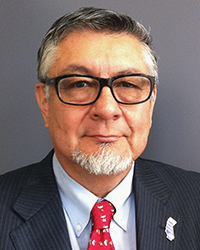An Emerging Narrative on Latino Health Disparities and its Implications in the COVID-19 Era
 Longstanding systemic health and social inequities have put Americans categorized as racial and ethnic minorities at greater risk of getting sick and dying from COVID-19, according to the Centers for Disease Control and Prevention. At the same time, Latinos have a history of good health outcomes, some of which contradict the prevailing narrative that race and ethnicity alone largely determine disparities in health outcomes.
Longstanding systemic health and social inequities have put Americans categorized as racial and ethnic minorities at greater risk of getting sick and dying from COVID-19, according to the Centers for Disease Control and Prevention. At the same time, Latinos have a history of good health outcomes, some of which contradict the prevailing narrative that race and ethnicity alone largely determine disparities in health outcomes.
For more than three decades, AIR Institute Fellow David E. Hayes-Bautista has researched Latino health outcomes. Using longitudinal data, he has reframed the narrative about diversity, race and ethnicity, and health. In this Q & A, Hayes-Bautista, distinguished professor of medicine and director of the Center for the Study of Latino Health and Culture at the David Geffen School of Medicine at UCLA, explains his findings and the implications for health care policy and practice.
Q: We hear a lot about disparities in health outcomes, mostly about how minorities have poorer health status. Your research has surfaced some counterintuitive findings. Can you explain?
Hayes-Bautista: Chronic diseases—heart disease, cancer, chronic lower respiratory diseases, stroke—are the leading causes of death in the U.S., accounting for about 60 percent to two-thirds of the mortality rate in any given year. These are lifestyle diseases. They depend largely upon how you live, whom you associate with, what you eat, how you move, and so on.
It turns out that particularly for chronic diseases, Latinos have about a 30 percent lower age-adjusted mortality rate than non-Hispanic whites. Latinos’ life expectancy is three-and-a-half years longer than that of whites. We’ve seen this in the data year after year for about 40 years, as I write about in my 2017 book, La Nueva California: Latinos from Pioneers to Post-Millennials. Yet this is surprising for many people.
Likewise, Latinos tend to have very, very good birth outcomes—a very low rate of infant mortality equivalent to that of whites and very low rates of low birth-weight babies, even better than whites. Latinos also smoke a lot less, drink a lot less, abuse drugs a lot less, according to national data.
While there are some variations in different regions of the country and in different Latino subpopulations, they tend to vary around a Latino epidemiological norm. They don’t vary around the national norm at all.
Q: Why do you think these findings are not as well-known as messages about poorer health status and outcomes for Latinos?
Hayes-Bautista: Race is woven into our medical world—the way we practice, the way we research. We assume there are biological differences between the races and that, therefore, there are differential health outcomes because of the biology of different races. This has yet to be scientifically proven. We assume that race is a hard-edged binary. But race is fuzzy. Latinos may be of any race, multiracial, or racially ambiguous.
We assume that diversity means dysfunctional health outcomes. We assume that social determinants of health—the conditions in the places where people live, learn, work, and play—are obstacles to good health outcomes. We have not been willing to look at the social determinants of health as facilitators of positive health outcomes. In Latino communities, this is known as the “barrio advantage.” Family, community, and social interactions in Latino neighborhoods have significant positive effects, over and beyond individual education or income, on health outcomes for breast cancer, cardiovascular health, birth outcomes, fall risks, sex practice risks, and mental health.
Q: In California, Latinos make up about 60% of COVID-19 cases and 39% of the population. Does that surprise you at all? How do these data points fit into the overall picture of your research findings?
Hayes-Bautista: COVID-19, which is a communicable disease, has different patterns than the chronic diseases I’ve mentioned. I cannot sneeze on you and give you a heart attack. I can just breathe on you and give you the coronavirus.
Initially, some attempted to connect higher COVID-19 case and death rates among Latinos to comorbidities, such as obesity and diabetes. Latinos do have higher rates of obesity and diabetes than some other populations, but comorbidities only come into play at the end of a very long trajectory of COVID-19.
The higher COVID-19 rates are connected to the very high work ethic of Latinos and the nature of work that many Latinos do. Latinos are essential workers. For the first two to three months of the pandemic, we took great pains to make sure that nurses and physicians had access to personal protective equipment (PPE). We didn’t even think about farm workers, construction workers, or food industry workers. The average grocery store checkout clerk probably has 200 to 300 clients pass within arm’s length on an average shift. With no PPE, a person in that occupation is hundreds of times more likely to be exposed to the coronavirus than someone who can stay at home.
The communicable disease pattern also has a lot to do with the lack of connection between Latino communities and the formal public health structure. Latinos are still twice as likely as others to be uninsured. They have less ability to seek health care services. For instance, a COVID-19 test can cost anywhere from a hundred dollars to $2,000. If you’re a farmer making $18,000 a year, that means one COVID test might cost up to two months of your income.
With much more exposure and much less likelihood of knowing they’ve been exposed, it’s not too surprising that Latinos have much higher case and death rates.
Q: What racial and ethnic health disparities should policy and decision makers pay attention to in the next few years, particularly as COVID-19 could have long-term health consequences?
Hayes-Bautista: Making the connection between Latino communities and the formal medical care system more robust would help. The United States is the only advanced industrial country that does not offer universal access to health care services to all people within its borders. Every other developed country has managed to do so—and they spend less in terms of GDP and per person than we do on health care.
We also have a tremendous physician shortage in the U.S. We have such a lack of Latino physicians in California that it will take all the current medical schools at the current rate of graduation 500 years to make up the shortage for 2015, much less Spanish-speaking physicians. Yet Latino physicians are far more likely to practice in heavily Latino areas and to speak Spanish. This needs to be addressed.
Q: What suggestions do you have for future research on racial and ethnic health disparities?
Hayes-Bautista: My advice for researchers is to pay attention to the basics—theory, method, and data. The theoretical models we use do not work for a diverse population. They have no predictive power for Latino, Asian, and American Indian populations. We need different theoretical models that can handle the epidemiology of diversity. We don’t know how to handle racial ambiguity because for so long our “science” has been based on the notion of separate, distinct biological races. We need to blow up all of our concepts and start almost de novo.
